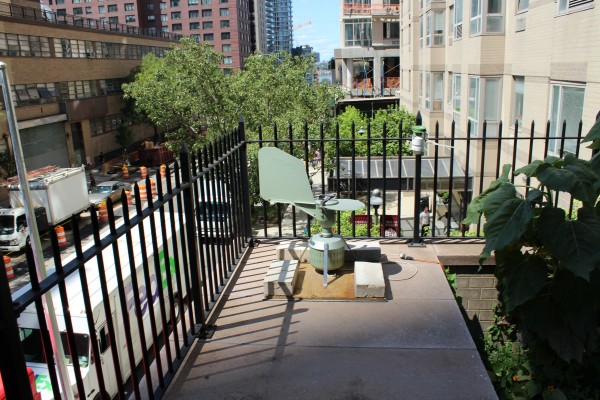Abandoned Garden Re-purposed by Fordham Research
September 8, 2015
Over the summer, a rotating machine was installed outside of McMahon Hall’s 2nd floor entrance, labeled in felt marker as “Fordham Pollen Machine.” This machine, known as an aeroallergen monitoring device, brings new purpose to a previously underutilized part of the Fordham community.
Guy Robinson, Ph.D. and lecturer in biology, explained the move was due to the construction of the old law school into a new student center, as the previous location of the machine was on the roof of the old law building. “We were already anticipating the move,” he said.
According to Robinson, an aeroallergen monitoring device is “a machine that picks up windblown pollen to create a representative record of pollen during allergy seasons. This machine is representative of midtown Manhattan.” The other monitoring station is located at The Louis Calder Center Biological Field Station, a Fordham operated research center located in Armonk, New York, 25 miles north of New York City.
Dr. Robinson runs the aeroallergen monitor there as well. “It’s not easy to run both of the stations, and I somehow got in charge of both of them. That’s why I only change out the samples for analysis every three days as opposed to every morning [at Lincoln Center],” he added.
“However we also have a lot more data up in Armonk, the database there goes back to 1998, Lincoln Center has only recorded allergen data since 2009,” he continued.
“[T]he machine records samples from wind based pollen … the garden itself is not affecting our samplings,” Robinson continued.
In fact, Fordham operates the only two allergen monitoring stations in New York. “We provide the data from the stations to a couple of databases, the National Air Allergen Bureau and Harvard’s School of Public Health.”
“Brian Byrne, the vice president of facilities I believe, suggested the garden since it wasn’t being really used.” Robinson continued. “I think it’s perfect since it’s fairly isolated from the rest of the plaza, but students can access it more easily.”
This is also good news for the students involved in the maintenance of the machine. “Undergraduate students are responsible for taking the accrued samples from the station and bringing them to the lab for analysis,” Robinson said.
According to Meghan Alvarez, (FCLC ‘17), who was living at Fordham over the summer, “the machine kind of appeared over the summer around July,” she said.
The machine’s origin was unclear to students like Alvarez, but Leslie Timoney, associate director of campus operations, confirmed the movement from the law school. “It was a project of the natural science department, and it was moved [to the communal garden] due to construction,” she said. “It was so the roof can be replaced for 2016.”.
The machine rotates in interval degrees, first 90 degrees, the 180 degrees, followed by a 360 degree revolution. It is unknown if the machine is helping with plant growth, but this does not appear to be the case. “There are some sunflowers that started growing, but they seem really sick … they look weird now,” Alvarez said.
Robinson explained the plant sickness and weed growth had nothing to do with the machine’s installation. When we arrived to install the station, we noticed there were a lot of vegetables, like tomatoes, and sunflowers growing in the garden. It looked like someone had planted them in the early summer,” Robinson said.
According to him, this is also what caused the outbreak of weeds in the garden. “It seems that the garden was ignored for a bit [over the summer] and that is why these insect-pollinated weeds sprang up.” The distinction of how the weeds and plants in the garden are pollinated is important since “the machine records samples from wind based pollen … the garden itself is not affecting our samplings,” Robinson continued.
For updates on New York City’s daily pollen count follow @FordhamPollen on Twitter.













